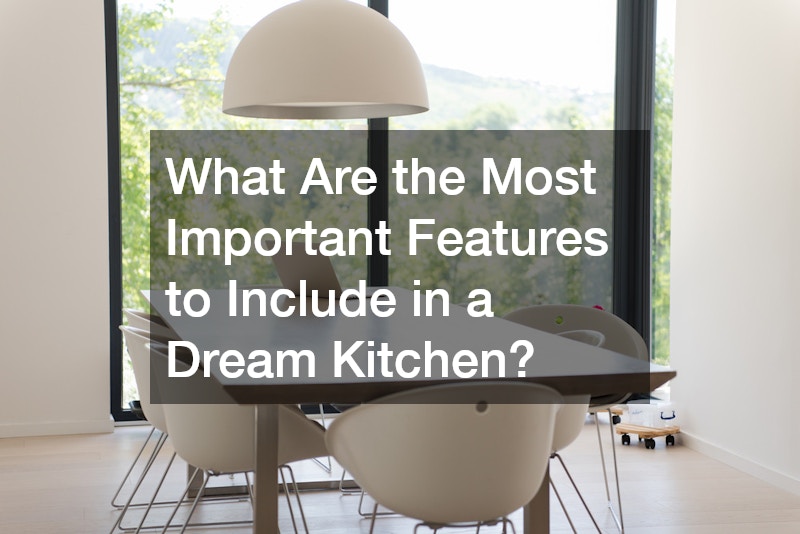A well-designed kitchen can significantly boost your home’s functionality and aesthetic appeal. It serves not only as a place to prepare meals but also as a central hub for family gatherings, entertaining guests, and expressing your personal style. Whether you are building a new home or remodeling your existing kitchen, careful planning is essential to ensure the space meets your needs. From selecting the right countertop to coordinating with skilled professionals such as flooring contractors and licensed electricians, every choice plays a role in crafting a space that is both practical and beautiful. In this article, we explore common questions, design principles, and practical tips to help you create the kitchen of your dreams.
What Are the Most Important Features to Include in a Dream Kitchen?

Optimal Layout Design
The foundation of any functional kitchen begins with a well-thought-out layout. A thoughtfully designed space allows for smooth movement, efficient workflow, and accessibility to key areas such as the sink, stove, and refrigerator. Choosing the right layout ensures that your kitchen feels spacious while accommodating all the activities that take place within it. Open layouts encourage social interaction, while more segmented designs can define work zones for cooking, cleaning, and prep. The layout you choose should also integrate with your flooring choices, whether you plan to install hardwood, tile, or carpet in adjoining spaces, ensuring a seamless visual flow.
High-Quality Appliances
Investing in high-quality appliances is critical for both convenience and longevity. Modern kitchen appliances offer advanced features such as convection ovens, smart refrigerators, and induction cooktops that simplify meal preparation. Selecting appliances with energy-efficient ratings not only reduces utility bills but also contributes to a sustainable kitchen environment. Additionally, appliances work best when paired with professional installation, which may include coordination with licensed electricians and residential electricians to ensure all wiring is safe and up to code.
Ample Storage Solutions
A dream kitchen requires efficient storage solutions to keep the space organized and clutter-free. Cabinets, drawers, and pantries should be strategically placed for accessibility. Pull-out shelves, lazy Susans, and vertical storage racks can help maximize space, making it easier to store and retrieve kitchen essentials. Plumbing supply closets and under-sink cabinets need thoughtful placement to avoid interfering with plumbing services and to ensure easy access for maintenance. Custom cabinetry allows homeowners to tailor storage to their unique needs, accommodating everything from large cookware to small utensils.
Durable Countertop Materials
Countertops play a dual role in both functionality and design. They must be durable enough to withstand frequent use while complementing the overall aesthetic of the kitchen. Granite countertop options remain popular for their resilience, natural beauty, and ability to resist heat and scratches. Other options, such as quartz or concrete, may appeal to homeowners seeking low-maintenance surfaces. Choosing the right countertop often involves coordination with other professionals, including interior painters, to ensure that the wall colors and backsplash designs harmonize with the countertop’s tones.
Efficient Lighting Options
Proper lighting is essential in a kitchen to ensure safety, convenience, and ambiance. Task lighting brightens work areas for cooking and preparation, while ambient lighting creates an inviting atmosphere for family meals and entertaining. Accent lighting can highlight design features or artwork, adding depth to the space. Incorporating under-cabinet lighting can illuminate work surfaces without creating glare, while coordinating with a licensed electrician ensures the electrical work meets safety standards. Layering multiple types of lighting guarantees that your kitchen is both functional and visually appealing.
How Do I Choose the Right Kitchen Layout?
Understanding Different Layouts
Kitchen layouts vary based on the available space and homeowner preferences. Popular configurations include L-shaped, U-shaped, galley, and island layouts. Each layout offers different benefits: L-shaped designs maximize corner space, U-shaped kitchens provide extensive counter and storage options, galley kitchens are ideal for narrow spaces, and island kitchens offer versatility and social interaction. Flooring contractors can help ensure that the kitchen layout aligns with the type of flooring installed, whether it is tile, hardwood, or even carpet in adjoining dining areas.
Evaluating Your Space
Before selecting a layout, carefully evaluate your kitchen’s dimensions, wall placement, and natural light sources. Understanding these factors will help you determine the most practical configuration. Consider how the layout will accommodate daily activities, including meal prep, cooking, and entertaining. Taking precise measurements and planning around existing infrastructure such as plumbing supply lines and electrical outlets can prevent costly mistakes during remodeling.
Traffic Flow Considerations
A functional kitchen layout should account for smooth traffic flow. Ensure that pathways remain unobstructed and that multiple people can move freely without collisions. Avoid placing appliances or cabinets in high-traffic zones, as this can impede movement. Proper traffic flow planning also makes it easier for residential electricians and plumbers to perform service work without disrupting your space.
Work Triangle Concept
The work triangle is a design principle that optimizes kitchen efficiency by positioning the sink, stove, and refrigerator in a triangular layout. This concept reduces unnecessary steps during meal preparation and ensures that each workstation is easily accessible. For homes undergoing remodeling, coordinating the work triangle with plumbing services and electrical installations is essential for both functionality and safety.
Customization for Specific Needs
Every family has unique needs that should be considered when designing a kitchen layout. Custom features such as adjustable shelving, pull-out pantry drawers, and multi-level islands allow the space to adapt to cooking habits and lifestyle. Consulting with interior painters and flooring contractors can help ensure that customized elements blend seamlessly with the kitchen’s overall design.
What Are the Latest Trends in Kitchen Design?

Open Concept Layouts
Open concept kitchens continue to dominate modern design. Removing walls or combining kitchen and living areas creates a spacious, social atmosphere where cooking and entertaining occur simultaneously. Open layouts often benefit from cohesive flooring choices, coordinated by experienced flooring contractors, to maintain visual continuity across spaces.
Smart Kitchen Technologies
Smart technology is revolutionizing kitchens. From refrigerators that monitor inventory to ovens controlled via smartphone apps, technology makes cooking more efficient. Integrating these systems often requires coordination with licensed electricians and residential electricians to ensure proper wiring and connectivity.
Sustainable Materials and Practices
Eco-friendly kitchens are gaining popularity, emphasizing sustainable materials and practices. Countertops made from recycled glass or responsibly sourced stone, low-VOC paints applied by interior painters, and energy-efficient appliances contribute to a more sustainable home.
Two-Tone Color Schemes
Two-tone kitchens, where upper and lower cabinets contrast in color, create a visually dynamic environment. Interior painters play a key role in selecting complementary wall colors and cabinet finishes to enhance this style.
Multi-Functional Kitchen Islands
Kitchen islands are more than just a prep area; they provide storage, seating, and sometimes even secondary sinks or cooktops. Custom islands may include pull-out drawers, under-counter cabinets, and integrated seating, making them central to the kitchen’s functionality.
How Can I Maximize Storage in My Kitchen?
Custom Cabinetry Solutions
Custom cabinetry allows homeowners to make the most of available space. Adjustable shelving, deep drawers, and hidden compartments keep kitchens organized while providing easy access to cookware and utensils.
Utilizing Vertical Space
Vertical storage is often underutilized in kitchens. Installing tall cabinets, shelving units, or hanging racks creates additional storage for rarely used items and keeps counters clear.
Innovative Pantry Designs
Pantries can be transformed with pull-out shelves, rotating racks, and dedicated storage containers. This approach ensures ingredients and supplies are organized and accessible, reducing clutter and improving efficiency.
Drawer Organizers and Inserts
Drawer organizers and inserts keep utensils, cutlery, and smaller kitchen tools neatly arranged. They prevent items from shifting during use, making it easier to find what you need quickly.
Convertible and Pull-Out Features
Innovative features such as pull-out cutting boards, under-sink organizers, and hidden trash bins maximize storage while maintaining a clean, streamlined appearance. Plumbing services are often necessary when integrating under-sink features to ensure proper installation.
What Materials Are Best for Kitchen Countertops?

Granite: Pros and Cons
Granite countertops are a durable, heat-resistant choice that adds elegance to any kitchen. While they are relatively low-maintenance, sealing is required to prevent stains and water damage. Pairing a granite countertop with complementary cabinetry and flooring ensures a cohesive design.
Quartz: Pros and Cons
Quartz countertops offer a non-porous surface that resists stains and scratches. Available in a wide range of colors and patterns, quartz allows for flexibility in design. This material works well with both traditional and modern kitchen styles.
Marble: Pros and Cons
Marble provides a timeless, luxurious look but requires more care to prevent staining and etching. Interior painters can coordinate wall colors to enhance marble’s natural veining, creating a sophisticated atmosphere.
Concrete: Pros and Cons
Concrete countertops offer a contemporary, industrial aesthetic. They are highly customizable in terms of color and texture but may require sealing to prevent water damage. Concrete pairs well with multi-functional kitchen islands and open-concept layouts.
Eco-Friendly Alternatives
Sustainable alternatives include recycled glass, reclaimed wood, and bamboo countertops. These materials reduce environmental impact while adding a unique character to your kitchen.
How Do I Select the Best Appliances for My Kitchen?
Energy Efficiency Ratings
Energy-efficient appliances reduce utility costs and environmental impact. Look for products with high Energy Star ratings to ensure long-term savings.
Appliance Size and Capacity
Choosing the right appliance size is essential to maintain workflow efficiency. Oversized appliances can overcrowd the kitchen, while undersized units may not meet your household’s needs.
Matching Aesthetic Styles
Appliances should complement the kitchen’s overall design. Stainless steel, matte finishes, and integrated designs can blend seamlessly with cabinetry and countertops.
Longevity and Durability
Durability is crucial when investing in appliances. Reliable brands and professional installation ensure your equipment will last for years without frequent repairs.
Advanced Features and Innovations
Modern appliances often include smart features, self-cleaning modes, and customizable settings. Incorporating these technologies may require coordination with licensed electricians to handle electrical demands safely.
What Lighting Options Work Best in a Kitchen?
Task Lighting Essentials
Task lighting illuminates specific work areas such as countertops, islands, and stovetops. Properly installed lighting ensures safe food preparation and cooking.
Ambient Lighting Solutions
Ambient lighting creates a warm, welcoming atmosphere. Layering ceiling fixtures and wall-mounted lights provides overall illumination while complementing natural light.
Accent Lighting for Ambiance
Accent lighting highlights design elements, such as a granite countertop, backsplash, or custom cabinetry. Interior painters can also select wall treatments that interact beautifully with accent lights.
Under-Cabinet Lighting Significance
Under-cabinet lighting brightens work surfaces without casting shadows. It also adds a modern, polished look to the kitchen.
Choosing LED Versus Incandescent
LED lighting is energy-efficient, long-lasting, and produces minimal heat. Incandescent lighting offers warmer tones but consumes more energy. Balancing these options ensures efficiency and comfort.
How to Budget for a Kitchen Remodel?
Setting Priorities and Goals
Begin by determining which elements are essential versus optional. Prioritizing areas such as countertops, appliances, and storage ensures your budget addresses critical needs first.
Understanding Average Costs
Kitchen remodel costs vary widely based on size, materials, and labor. Consulting professionals, including flooring contractors, painters, and licensed electricians, can provide accurate estimates.
Splurging Versus Saving
Decide where to splurge and where to save. High-traffic areas like countertops may justify a larger investment, while decorative elements may offer more flexibility.
Hiring Professionals vs. DIY
Some projects, such as plumbing services or electrical work, require licensed professionals for safety and compliance. Other tasks, like painting walls or installing construction dumpsters for debris removal, can be handled by experienced DIY homeowners.
Staying Flexible with Unexpected Expenses
Unexpected challenges, such as plumbing supply updates or flooring adjustments, can arise during a remodel. Maintaining a contingency fund ensures you can handle surprises without compromising the project.
What Are Some Eco-Friendly Kitchen Remodeling Tips?

Choosing Sustainable Materials
Opt for recycled, reclaimed, or responsibly sourced materials for countertops, cabinets, and flooring. This reduces environmental impact and contributes to a healthier home.
Energy-Efficient Appliance Selection
Select appliances with high efficiency ratings to reduce energy consumption. Smart appliances can further optimize usage and minimize waste.
Water-Saving Fixtures
Install low-flow faucets, efficient dishwashers, and other water-saving fixtures to reduce water use while maintaining convenience.
Recycling and Upcycling
Incorporate recycled or upcycled materials, such as repurposed cabinetry or reclaimed wood shelves, to give your kitchen a unique character and reduce waste.
Redesigning for Waste Reduction
Plan your kitchen layout to include compost bins, recycling stations, and efficient storage to minimize food waste and keep your space organized.
How to Personalize Your Kitchen Space?
Incorporating Personal Style
Integrate colors, textures, and materials that reflect your personality. Whether it’s a bold backsplash, unique countertop, or patterned carpet in adjacent spaces, personal style makes the kitchen truly yours.
Adding Unique Accessories
Decorative items, such as vases, bowls, and kitchen tools, enhance the visual appeal of the space. Coordinating accessories with the overall theme creates a cohesive look.
Choosing Distinctive Hardware
Cabinet handles, drawer pulls, and faucets are small details that make a big impact. Selecting unique hardware adds charm and personality to your kitchen.
Personalized Backsplash Designs
Custom backsplash designs provide an opportunity to incorporate color, texture, and artistry into your kitchen. Interior painters can help blend the backsplash with surrounding wall colors for a harmonious finish.
Custom Artwork and Decor
Displaying custom artwork, framed prints, or sculptures adds a personal touch to your kitchen. Even small decorative elements contribute to a space that feels welcoming and tailored to your taste.
Closing Thoughts
Creating your dream kitchen requires thoughtful planning and consideration of various elements, from selecting a granite countertop and coordinating with flooring contractors to hiring licensed electricians and skilled interior painters. Attention to layout, storage, lighting, and eco-friendly practices ensures a functional, stylish, and sustainable space. By integrating personal touches, investing in quality materials, and collaborating with experienced professionals for plumbing services, carpentry, and electrical work, you can design a kitchen that perfectly suits your lifestyle and preferences, making it the heart of your home.
